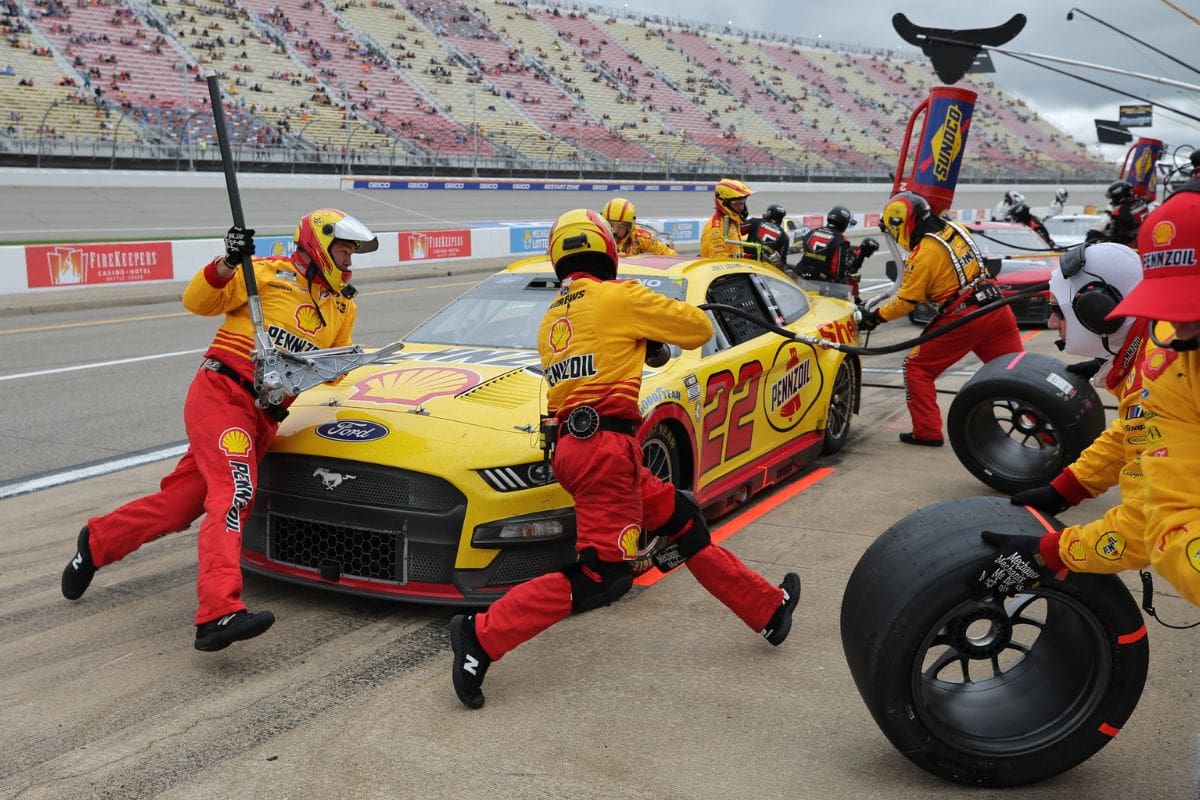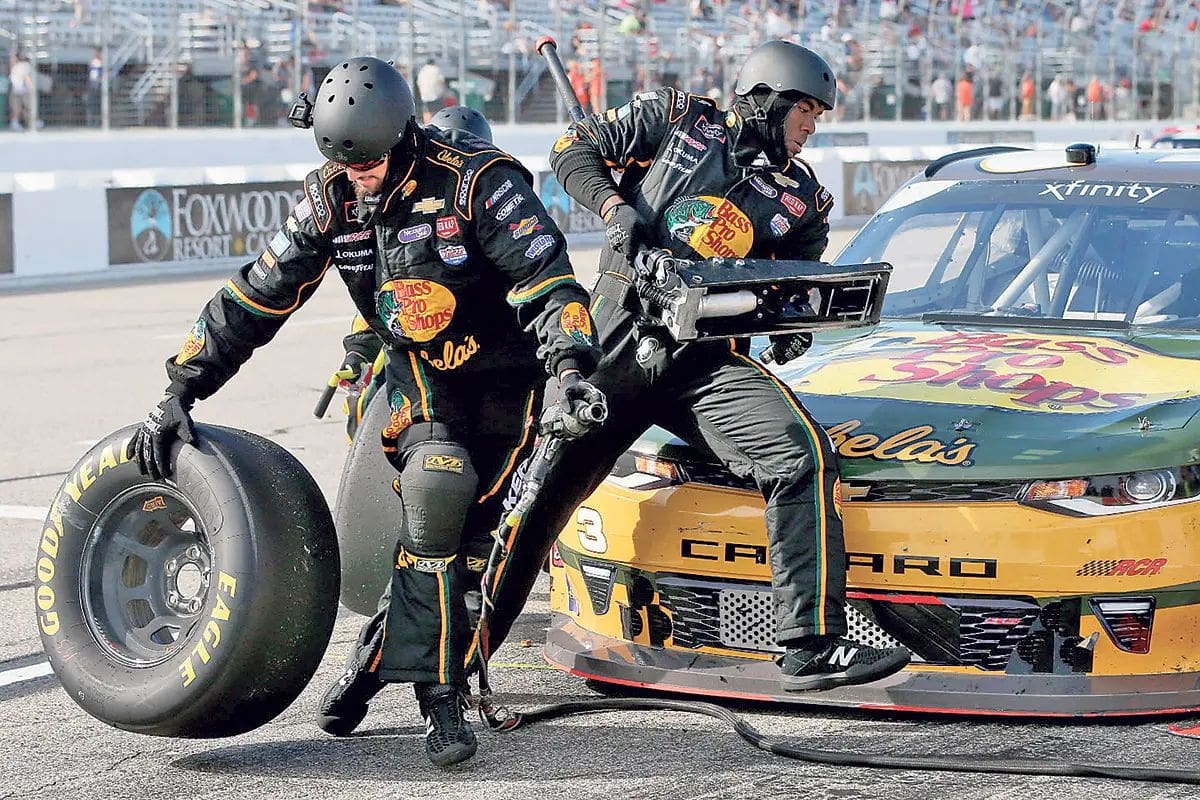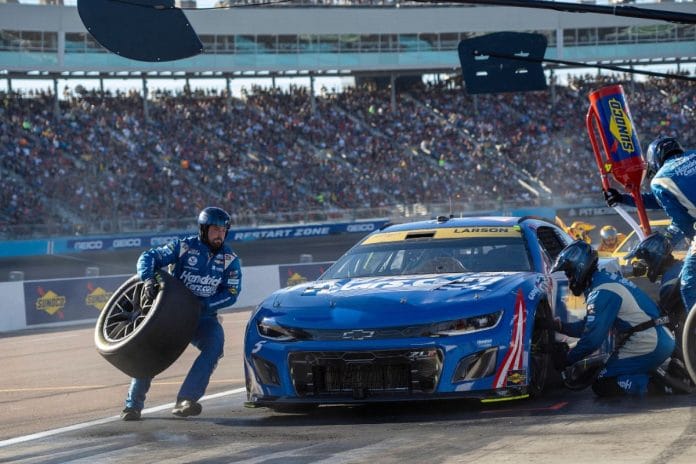NASCAR Pitstop Challenges: NASCAR pit stops are critical points that can drastically influence race results, and Joe Gibbs Racing has emerged as a leader in mastering these high-pressure moments. By implementing tactical variations—such as two-tire versus fuel-only stops—the team demonstrates a subtle understanding of when to optimize for speed versus stability. Their commitment to precision and crew coordination improves their competitive edge and adapts seamlessly to evolving regulations. As we investigate the intricacies of their approach, it becomes evident that the true secrets of their success may lie deeper than mere mechanics. What could these hidden factors be?
Key Highlights
- Joe Gibbs Racing emphasizes crew coordination and precise timing to execute efficient pit stops, crucial for maintaining competitive positions on the track.
- The team strategically selects between four-tire, two-tire, and fuel-only stops based on race dynamics and tire wear.
- Innovative strategies, like a two-stop approach at COTA, showcase their commitment to adapting to unique track challenges effectively.
- Consistent fast pit stop times, such as Denny Hamlin’s 8.59 seconds, highlight the crew’s skill and preparation under pressure.
Importance of Pit Stops in NASCAR
Pit stops in NASCAR are not merely routine maintenance intervals; they are critical tactical moments that can decisively influence the outcome of a race, often determining the difference between victory and defeat. The irony of a sport characterized by speeds exceeding 200 mph is that the race can hinge on how efficiently a team executes a moment of complete stillness. This paradox underlines the strategic importance of minimizing pit stop duration while maximizing their effectiveness.
Strategically, the timing and execution of pit stops can alter a driver’s position on the track, especially as they often occur during crucial moments such as cautions or race restarts. A well-coordinated pit crew can make a difference of moments, which can translate into positions gained or lost as cars re-enter the race. In NASCAR, where the field is closely contested, these moments can be the difference between leading the pack or falling behind.
Moreover, the decision-making process surrounding pit stops extends beyond mere tire changes and fuel replenishment. It incorporates real-time assessments of tire wear, fuel consumption, and race dynamics. Understanding when to pit is as fundamental as executing the pit stop itself, necessitating a keen analysis of race conditions and competitor strategies.

Different Types of Pit Stops in NASCAR
Understanding the varied types of pit stops in NASCAR is essential to grasping how teams tactically navigate within the complexities of race conditions, as each decision made in the pit can considerably impact a driver’s performance on the track. Different types of pit stops serve multiple tactical objectives, allowing teams to optimize speed and efficiency during critical moments of a race.
The three primary types of pit stops include: four-tire changes, two-tire changes, and fuel-only stops. Each type caters to specific race situations, balancing the need for speed against the car’s performance requirements.
View this post on Instagram
The execution of these pit stops relies heavily on precise timing and coordination among crew members, as evidenced by Joe Gibbs Racing’s 6th best pit stop time at the Circuit of the Americas. As teams adjust their tactics, understanding when to employ each type of pit stop becomes vital. Consequently, mastering the art of pit stops not only improves a team’s performance but also adds a layer of tactical depth to the complete racing experience.
Types of Pit Stops Explained
In NASCAR, the tactical deployment of different pit stop types—each tailored to specific race conditions—plays an essential role in optimizing performance and maintaining competitive advantage on the track. The tactical selection of pit stop types can greatly influence a team’s positioning and overall race outcome.
One prevalent strategy is the two-tire pit stop, primarily employed to gain track position quickly. This method typically involves changing only the right-side tires, which experience more wear due to the car’s weight distribution during turns. By limiting the time spent in the pits, teams can capitalize on fresh rubber while minimizing the time lost on pit road.
Conversely, the fuel-only pit stop is often executed towards the end of a stage or race. This approach guarantees that the vehicle has sufficient fuel to complete the event without altering tire performance, thereby maximizing efficiency and reducing the frequency of pit stops.
The most thorough strategy involves a four-tire pit stop, where teams replace all four tires and refuel the car. This is vital for maintaining competitive speed and grip on the track. Joe Gibbs Racing has mastered this technique, frequently completing their four-tire and fuel stops within an impressive nine seconds, highlighting the importance of efficiency during these critical moments.

The COTA Pit Stops
Tactical decision-making during the COTA pit stops can considerably impact race outcomes, as teams navigate the delicate balance between speed and fuel management to optimize their performance on the challenging Circuit of the Americas. The unique configuration of COTA, with its diverse elevation changes and technical turns, requires teams to adopt subtle strategies that can either improve or hinder their competitiveness.
The Joe Gibbs Racing team, particularly the No. 20 car, highlighted an inventive approach by opting for a bold two-stop strategy instead of the conventional three. This decision was rooted in several critical considerations:
- Fuel Efficiency: By holding the car for longer during the pit stop to guarantee adequate fuel, the team aimed to sustain performance levels over an extended run. This strategy minimized the frequency of stops, reducing time lost on pit road.
- Tire Management: With fewer pit stops, the No. 20 team was able to keep tire degradation in check, allowing the driver to maintain consistent lap times without the interruption of additional stops.
- Competitive Edge: The gamble of fewer stops not only tested the crew’s precision but also offered the potential to capitalize on the competition’s inevitable missteps or delays during their more frequent stops.
Fastest Pit Stops of the Season
The battle for supremacy in NASCAR extends beyond the racetrack, with pit crews emerging as essential players in the quest for victory, as evidenced by the remarkable speeds recorded during the fastest pit stops of the season. This year, the competition on pit road has reached unprecedented levels, showing the intricate synergy and precision required in a sport where milliseconds can dictate the outcome of a race.
The No. 11 crew of Denny Hamlin from Joe Gibbs Racing has set a benchmark with an astonishing pit stop time of just 8.59 seconds for a four-tire change, marking a season record that highlights the crew’s exceptional skill and coordination. This performance is not merely an outlier; rather, it reflects a broader trend where every entry in the top 10 fastest stops has clocked in below nine seconds. Such consistency under stress shows the rigorous training and tactical planning that teams employ to refine their pit stop techniques.
Crews from both Joe Gibbs Racing and Hendrick Motorsports dominate this elite list, indicating their commitment to optimizing every aspect of pit performance. The evolution of pit stop strategies, especially since the introduction of new regulations in 2017, has necessitated adaptability and innovation from all teams.
As the season progresses, the quest for the fastest pit stops remains a vital component of the comprehensive racing strategy, emphasizing the profound impact that pit crews have on the dynamics of NASCAR.

News in Brief: NASCAR Pitstop Challenges
The analysis of NASCAR pit stop strategies, particularly those employed by Joe Gibbs Racing, highlights the critical influence of timing and crew coordination on race outcomes.
The team’s adeptness at executing different pit stop types, such as two-tire and fuel-only changes, demonstrates a commitment to maintaining competitive positioning.
Additionally, the consistent performance in achieving rapid pit stops reflects an ability to adapt to evolving regulations, ultimately enhancing overall race performance and contributing to success on the track.
ALSO READ: NASCAR’s Playoff Format: How 10 Years of Changes Shaped the Sport

